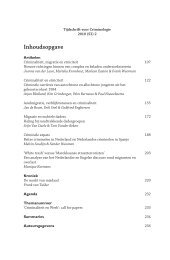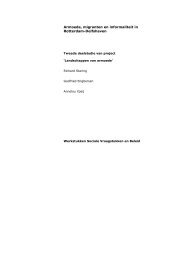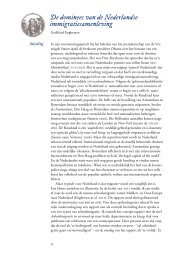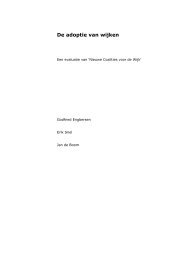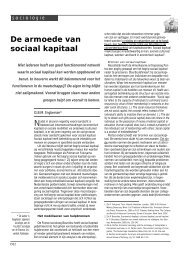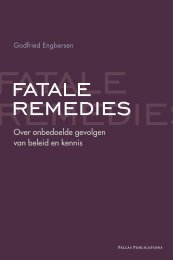THE SOCIAL CONSTRUCTION OF ILLEGALITY AND CRIMINALITY ...
THE SOCIAL CONSTRUCTION OF ILLEGALITY AND CRIMINALITY ...
THE SOCIAL CONSTRUCTION OF ILLEGALITY AND CRIMINALITY ...
You also want an ePaper? Increase the reach of your titles
YUMPU automatically turns print PDFs into web optimized ePapers that Google loves.
<strong>THE</strong> <strong>SOCIAL</strong> <strong>CONSTRUCTION</strong> <strong>OF</strong> <strong>ILLEGALITY</strong> <strong>AND</strong> <strong>CRIMINALITY</strong> 13<br />
The second pattern entails bounded solidarity (cf. Portes 1995). Particularly<br />
Moroccan illegal immigrants are often confronted with limited<br />
forms of support from their own community. Support is given to a less<br />
exclusive and, consequently, larger circle of compatriots. In specific situations,<br />
people feel called upon to help illegal compatriots who are confronted<br />
with setbacks and who they feel connected to. However, this help<br />
is limited and restricted. It often pertains to financial aid, but it can also<br />
involve incidental help such as providing medicine, introducing illegal<br />
immigrants to potential employers and marriage partners, or serving as an<br />
interpreter in the contacts with lawyers or physicians. In this support pattern,<br />
the help is focused on illegal immigrants with whom the legal immigrants<br />
have weaker ties. In this model there is also an asymmetrical relation<br />
between the legal support giver and the illegal support recipient, but it is<br />
not a relation of permanent dependence, rather a more anonymous and less<br />
personal relation in which incidental favours are granted.<br />
The third incorporation pattern is based upon market relations between<br />
the legal providers of jobs, housing, documents and so forth and the illegal<br />
immigrants who need these (cf. Mahler 1995). In our study, the groups<br />
of Moroccans and Africans were dependent on such market relations.<br />
Employers give them jobs (often low-paid), and landlords rent out apartments,<br />
rooms and beds to them. Illegal immigrants can also buy or hire<br />
the documents they need (passports, identification cards, health insurance<br />
cards, social-fiscal numbers). In this third incorporation pattern, there is<br />
an asymmetrical relation between the two parties. A contractual agreement<br />
can always be cancelled, for example, if illegal workers or tenants are not<br />
submissive enough or violate certain rules of conduct. Labour and housing<br />
conflicts are then settled by firing or evicting the illegal immigrants or<br />
by simply refusing to pay them for the work they have done.<br />
The empirical results make clear that there are differences in the extent<br />
to which illegal immigrants are incorporated and helped by their ethnic<br />
communities. These differences in informal incorporation patterns provide<br />
a partial explanation for the illegal immigrants’ differential involvement<br />
in various forms of crime. The low crime rate among illegal Turks is partly<br />
the result of their embeddedness in the Turkish community. Their relations<br />
with relatives and other compatriots in the Netherlands grant them access<br />
to specific forms of support and make them less dependent on crime to<br />
survive in the Netherlands. Quite the opposite is the case with illegal<br />
Moroccans, who often have to manage on their own without a supportive<br />
network. Forms of survival criminality are the only option for some of them.<br />
Illegal Africans occupy a position that lies in between that of the Turks<br />
and Moroccans. They can rely on more support from their own ethnic



